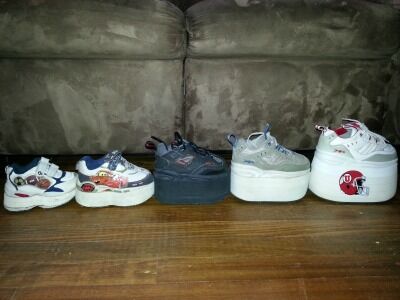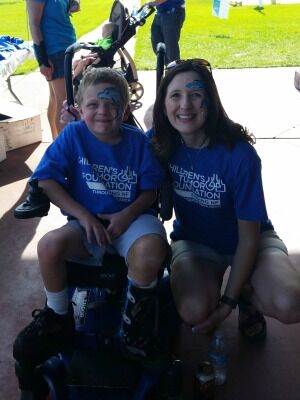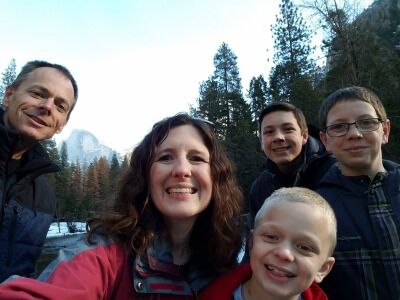As the youngest of 3 boys, Travis’ biggest concerns should have been keeping up with his brothers and what games they could play. As parents, our biggest concern should have been that we were outnumbered…3 kids to 2 parents. However, life brought a different set of challenges. Travis’ first café au lait spots appeared shortly before 4 months of age and the NF1 diagnosis by our pediatrician followed at 6 months. To see his medical issues on paper, you would never guess how well he functions in the world. His spirit remains positive throughout all the challenges he faces due to NF.
At 18 months, shortly after his first genetics appointment, Travis’ leg length discrepancy appeared (left longer than right), which significantly increased from 1.5 cm to 4 cm over the next 9 months. Travis started walking with a bowed femur, abnormal left hip structure (left hip bones larger than right), thin left femur, knock-kneed on the left side, and bowed left tibia.
Two weeks later an MRI confirmed an enormous, encompassing plexiform neurofibroma that extended over 50% of Travis’ body length. The tumor starts in his lumbar spine (L1-L5), invades his left hip joint (both in front and behind), infiltrating and surrounding every muscle compartment in his left thigh, past the knee, and extending down to his left ankle.
 At the tender age of 3, we decided to move our family to Salt Lake City to be closer to Dr. Viskochil and his orthopedic team at Shriners Hospitals for Children – Salt Lake City, and enroll Travis in his first clinical trial (rapamycin through the CDMRP). Unfortunately, after 15 cycles, the tumor continued to grow over 20%, so we removed him from the trial. After a year, we restarted the rapamycin, at our cost, since it appeared to slightly slow the progression, but the tumor continued to grow (40% in 6 months). We immediately started searching for another option.
At the tender age of 3, we decided to move our family to Salt Lake City to be closer to Dr. Viskochil and his orthopedic team at Shriners Hospitals for Children – Salt Lake City, and enroll Travis in his first clinical trial (rapamycin through the CDMRP). Unfortunately, after 15 cycles, the tumor continued to grow over 20%, so we removed him from the trial. After a year, we restarted the rapamycin, at our cost, since it appeared to slightly slow the progression, but the tumor continued to grow (40% in 6 months). We immediately started searching for another option.
Throughout this time, Travis’ leg length discrepancy increased to over 9 cm. By spring of 2015, Travis had also endured two femur fractures that required three surgeries to repair. In addition to the fracture repairs, the surgeons inserted an IM rod, reducing his femur by 5 cm to help even the leg length discrepancy, as well as inserted an 8-plate to start the left knock-knee correction. That’s a lot of intense recovery, but Travis’ spirit remained high and his determination unwavered! Three surgeries affecting his bones at the age of 7 and still he smiles.
 In February 2015, Travis was enrolled in the peg-interferon clinical trial at the NIH, at the end of which, the volumetric results indicated only a 10% growth, slower than before the trial. We celebrated his last injection, praying and hoping better methods of slowing and/or shrinking tumor growth lay ahead. There had to be a better way, a way without a parent injecting their child with chemo. I still cry when I think about it. (Photo left: Travis before starting MEK-inhibitor AZD6244)
In February 2015, Travis was enrolled in the peg-interferon clinical trial at the NIH, at the end of which, the volumetric results indicated only a 10% growth, slower than before the trial. We celebrated his last injection, praying and hoping better methods of slowing and/or shrinking tumor growth lay ahead. There had to be a better way, a way without a parent injecting their child with chemo. I still cry when I think about it. (Photo left: Travis before starting MEK-inhibitor AZD6244)
Travis enrolled in the MEK-inhibitor AZD6244 (Selumetinib) at the NIH in November 2015, his third clinical trial by the age of 8. At the start of the trial, the measured part of Travis’ tumor neared 1.75 liters. After 16 cycles, Travis’ tumor is now 31.5% smaller!! Thankfully this treatment brings minimal side effects; the most noticeable is a dramatic lightening of his hair color.
Today, Travis runs around, plays baseball, skis through the National Ability Center, participates in other adaptive sports, and remains his happy self on an essentially dislocated left hip. He wears an AFO to protect his bowed tibia and uses mobility devices as needed to move around (cane, walker, and power chair). If the physical challenges weren’t enough, learning disabilities challenge Travis in school. While he works harder than other students, learning remains difficult. But he does not quit!
In Travis’ short lifetime, he’s experienced the benefits of better clinical trials that offer a life full of fun, smiles, laughter, and happiness. In less than 7 years of clinical trials, Travis’ tumor response changed from greater than 20% growth to shrinkage by nearly one-third. Since starting MEK, we have noticed a huge, positive change in Travis’ mobility. We often see him “ditch his walker” and opt for independent walking. Today, one of Travis’ biggest concerns is how he will beat his brothers in games. So much progress in the lifetime of a child. Travis remains a force to be reckoned with as he endures his challenges with a resiliency experienced by only a few people across the world. Our biggest hope…better things to come.


